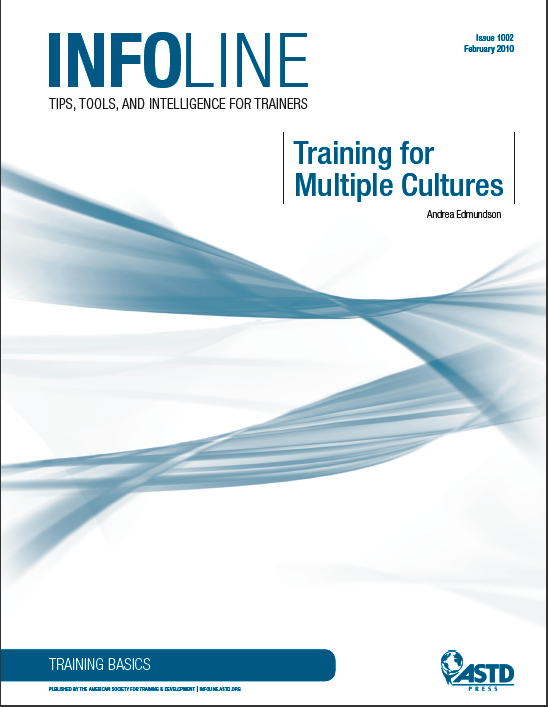Training for Multiple Cultures is a short (think booklet-sized) addition to ASTD’s Infoline series. I take responsibility for choosing this book, but based on the title I was expecting something on how to develop or deliver instruction (live, synchronous, asynchronous) to mixed groups – people from different cultures all working together.
My own challenges – and I share them with many of my U.S.-based colleagues – lie with maximizing the learning experience for the worker who has come into the American workplace from another culture. Rather, this piece is intended for the American trainer or instructional designer delivering or creating instruction for delivery in another part of the world. So, my own expectations aside, here’s my take on Training for Multiple Cultures.
Focus on Asia
 Andrea Edmundson provides a tight,
concise overview of her subject matter, focusing in particular on cases
involving learners in China and, to a lesser extent, Japan and India. She
offers a nice overview of concepts related to leadership, power, and learning.
For instance, in contrast to the American individualistic “WIIFM” (“What’s In
It For Me”) approach as a motivational tool for learning, learners in China may
be more interested in working for the good of the group. They may be
uncomfortable with lone-learner activities, particularly those tinged with
competition. They may also think of “learning” largely as a memorization
activity. This is not to say experiential, constructivist approaches won’t
work, but it is to say we should be mindful that there may need to be time for
orienting the learners to the less-familiar approach. Noting that learners in
some cultures may be hesitant to challenge authority, Edmundson asserts that
learners in India may view the trainer as “teacher,” and defer to that person
as someone imparting greater wisdom (I know some American classroom trainers
who would give anything to be viewed that way).
Andrea Edmundson provides a tight,
concise overview of her subject matter, focusing in particular on cases
involving learners in China and, to a lesser extent, Japan and India. She
offers a nice overview of concepts related to leadership, power, and learning.
For instance, in contrast to the American individualistic “WIIFM” (“What’s In
It For Me”) approach as a motivational tool for learning, learners in China may
be more interested in working for the good of the group. They may be
uncomfortable with lone-learner activities, particularly those tinged with
competition. They may also think of “learning” largely as a memorization
activity. This is not to say experiential, constructivist approaches won’t
work, but it is to say we should be mindful that there may need to be time for
orienting the learners to the less-familiar approach. Noting that learners in
some cultures may be hesitant to challenge authority, Edmundson asserts that
learners in India may view the trainer as “teacher,” and defer to that person
as someone imparting greater wisdom (I know some American classroom trainers
who would give anything to be viewed that way).
The author offers concrete suggestions for managing this less-familiar approach. She discusses adaptations ranging from, at the one end, simply translating material to another language, or then being more mindful of simple etiquette (don’t expect those typing in a second language to keep up with fast Webinar text chat). At the other end you can “localize” a program to appear that it was developed by and for the culture, or you can simply start development for that culture from scratch.
Summary
Training for Multiple Cultures includes a couple of nice job aids, including a table outlining potential adaptations and a Cultural Analysis Framework Checklist. Having spent lots of time immersed in “diversity” work I am always cautious of sweeping generalizations about any group: you don’t have to go to China to find people who think titles are more important than accomplishments, or leaders who don’t believe in asking employees for feedback. I’d advise, then, that readers keep a grain of salt handy or, better yet, do fairly extensive research of their own target audiences. Edmundson ends with a call for those conducting such research to share what they find out.
A few negative things, none I consider terribly detrimental: first, I would have liked to have seen a little more information on intercultural matters, such as some information on dealing with groups that include learners from several cultures at once. I question whether a “novice” could really conduct the cultural analysis she recommends, and I wonder, just a little, if some of the generalizations about other cultures aren’t a bit overstated. Also, apart from the analysis tools, I didn’t see much that is new here – we’ve seen lots of studies about Japanese learners, for instance – but kudos to Andrea Edmundson for getting it all in one place. Overall, the piece is very tight, focused, and clear, and is certainly worth the $12 purchase price.
Bibliographic information
Edmundson, Andrea. (February 2010). Training for Multiple Cultures. ASTD Press Infoline Series. ISBN 978-1-56286-722-5 16 pages, $12



